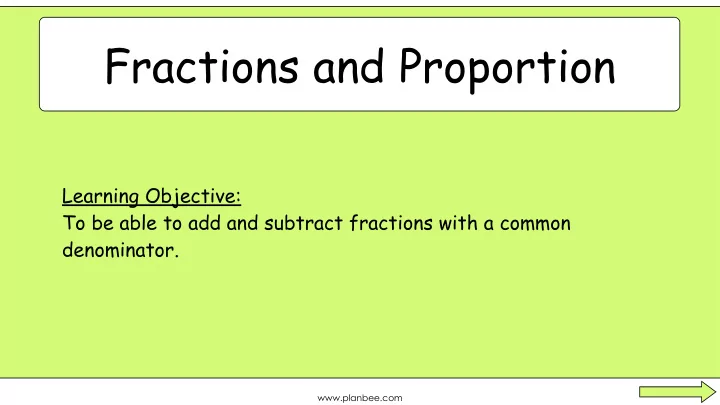

Fractions and Proportion Learning Objective: To be able to add and subtract fractions with a common denominator. www.planbee.com
9 7 + = 10 10 How could you find the answer to the question? Do you know what the answer is? www.planbee.com
9 7 = 16 + 10 10 10 When you are adding fractions with the same denominator, you can simply add the numerators together. The denominator remains the same. Let’s have a look at an example to explain this concept... www.planbee.com
An egg carton has ten 9 7 = 16 + holes to hold ten eggs. 10 10 10 Imagine one egg carton had nine eggs in and one had seven eggs. To work out how many eggs there are altogether, we just add the eggs up. There are sixteen eggs altogether but there are still only ten holes in each egg carton. The egg cartons themselves haven’t got any bigger. www.planbee.com
We can then move the eggs around so that we have one full egg carton and one carton that has six eggs in it. Does that 9 7 = 16 6 1 make sense? + 10 = 10 10 10 www.planbee.com
4 5 + = 7 7 Can you solve this fraction addition problem? See if you can express the answer as both an improper and a mixed number fraction? www.planbee.com
4 5 9 2 1 + = 7 = 7 7 7 Did you get that right? www.planbee.com
7 10 + = 12 12 Have a go at this one. Can you express the answer as both an improper and a mixed number fraction? www.planbee.com
7 10 = 17 5 1 + 12 = 12 12 12 Did you get that one right? How did you work it out? www.planbee.com
9 6 - = 10 10 How do you think you could work this one out? What will the answer be? www.planbee.com
9 6 3 - = 10 10 10 This was a subtraction problem. Because we were taking away, we are left with a proper fraction as the answer so we don’t need to convert it! www.planbee.com
8 13 + = 16 16 Try this one! What’s the answer as an improper and a mixed number fraction? www.planbee.com
8 13 = 21 5 1 + 16 = 16 16 16 Well done if you got that one! www.planbee.com
4 1 1 - = 6 6 Hmm...here we are taking away a proper fraction from a mixed number fraction. How could we solve this problem? www.planbee.com
4 4 = 3 1 7 1 - - = 6 6 6 6 6 The easiest way to solve a problem like this is to convert the mixed number fraction to an improper fraction. We can then easily take away the numerators to find the answer. Let’s try a similar question! Are you ready...? www.planbee.com
3 1 2 - = 4 4 See if you can solve this problem! Remember to convert the mixed number fraction to an improper fraction to help you! www.planbee.com
3 3 = 6 2 1 9 1 2 - - 4 = = 4 4 4 4 4 Bravo if you got that one right! Did you convert the improper fraction answer at the end to a mixed number fraction? www.planbee.com
2 4 2 1 5 + = 5 Have a look at this problem? How could you solve it? www.planbee.com
= 4 = 3 1 6 2 1 4 = 1 + 2 + 4 2 2 1 + 5 + + 5 5 5 5 5 5 1 9 = 21 2 4 12 4 2 1 = 5 + = + 5 5 5 5 5 Have a look at these two different ways of solving this problem. Can you see how they’ve been solved? Which method do you think is easiest? www.planbee.com
Well done everyone! Are you ready to try adding and subtracting fractions on your own? www.planbee.com
Plenary: 1 3 + = 4 8 When we add or subtract fractions, we need to have a common denominator (the same denominator for each fraction). So how could we solve this problem? www.planbee.com
1 3 = 2 3 = 5 + + 4 8 8 8 8 We have to convert the fractions so that we have a common denominator. In this example, we can convert one quarter to two eighths (which are equivalent fractions). We can then add the fractions together. Let’s try some more examples! Are you ready? www.planbee.com
1 2 + = 6 3 Can you solve this problem? How can you find a common denominator? www.planbee.com
1 2 = 1 4 = 5 + + 6 3 6 6 6 Did you get that one? Why couldn’t we convert the denominator to thirds? www.planbee.com
4 7 + = 5 10 Last one! Have a go at this problem. Good luck! www.planbee.com
4 7 = 8 7 15 10 = 1 5 + + = 5 10 10 10 10 Well done if you got that one! These are tricky! www.planbee.com
Recommend
More recommend